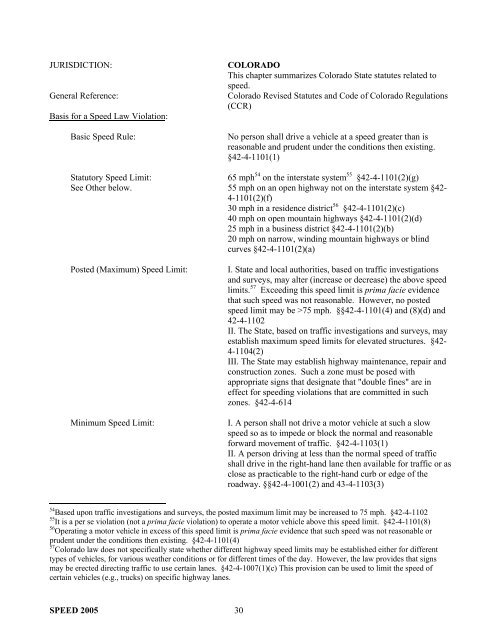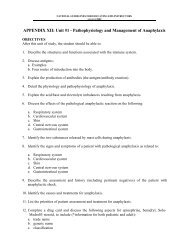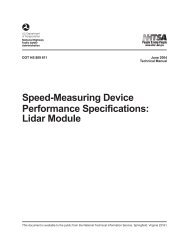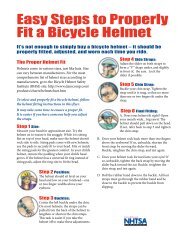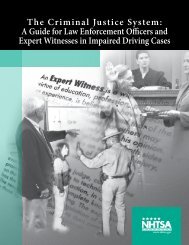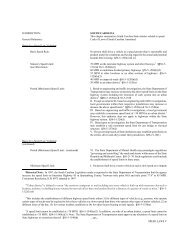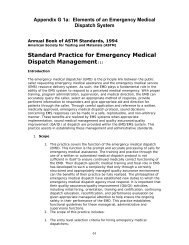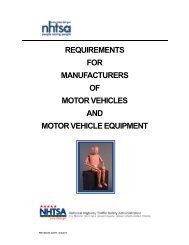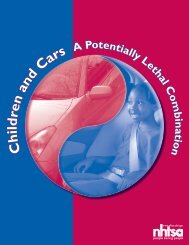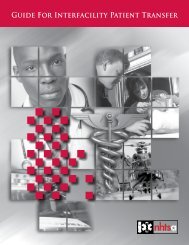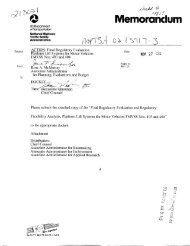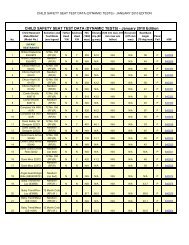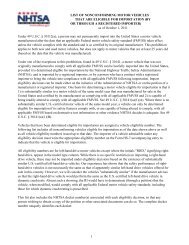Summary of State Speed Laws - NHTSA
Summary of State Speed Laws - NHTSA
Summary of State Speed Laws - NHTSA
Create successful ePaper yourself
Turn your PDF publications into a flip-book with our unique Google optimized e-Paper software.
JURISDICTION: COLORADO<br />
This chapter summarizes Colorado <strong>State</strong> statutes related to<br />
speed.<br />
General Reference: Colorado Revised Statutes and Code <strong>of</strong> Colorado Regulations<br />
(CCR)<br />
Basis for a <strong>Speed</strong> Law Violation:<br />
Basic <strong>Speed</strong> Rule: No person shall drive a vehicle at a speed greater than is<br />
reasonable and prudent under the conditions then existing.<br />
§42-4-1101(1)<br />
Statutory <strong>Speed</strong> Limit: 65 mph 54 on the interstate system 55 §42-4-1101(2)(g)<br />
See Other below. 55 mph on an open highway not on the interstate system §42-<br />
4-1101(2)(f)<br />
30 mph in a residence district 56 §42-4-1101(2)(c)<br />
40 mph on open mountain highways §42-4-1101(2)(d)<br />
25 mph in a business district §42-4-1101(2)(b)<br />
20 mph on narrow, winding mountain highways or blind<br />
curves §42-4-1101(2)(a)<br />
Posted (Maximum) <strong>Speed</strong> Limit: I. <strong>State</strong> and local authorities, based on traffic investigations<br />
and surveys, may alter (increase or decrease) the above speed<br />
limits. 57 Exceeding this speed limit is prima facie evidence<br />
that such speed was not reasonable. However, no posted<br />
speed limit may be >75 mph. §§42-4-1101(4) and (8)(d) and<br />
42-4-1102<br />
II. The <strong>State</strong>, based on traffic investigations and surveys, may<br />
establish maximum speed limits for elevated structures. §42-<br />
4-1104(2)<br />
III. The <strong>State</strong> may establish highway maintenance, repair and<br />
construction zones. Such a zone must be posed with<br />
appropriate signs that designate that "double fines" are in<br />
effect for speeding violations that are committed in such<br />
zones. §42-4-614<br />
Minimum <strong>Speed</strong> Limit: I. A person shall not drive a motor vehicle at such a slow<br />
speed so as to impede or block the normal and reasonable<br />
forward movement <strong>of</strong> traffic. §42-4-1103(1)<br />
II. A person driving at less than the normal speed <strong>of</strong> traffic<br />
shall drive in the right-hand lane then available for traffic or as<br />
close as practicable to the right-hand curb or edge <strong>of</strong> the<br />
roadway. §§42-4-1001(2) and 43-4-1103(3)<br />
54 Based upon traffic investigations and surveys, the posted maximum limit may be increased to 75 mph. §42-4-1102<br />
55 It is a per se violation (not a prima facie violation) to operate a motor vehicle above this speed limit. §42-4-1101(8)<br />
56 Operating a motor vehicle in excess <strong>of</strong> this speed limit is prima facie evidence that such speed was not reasonable or<br />
prudent under the conditions then existing. §42-4-1101(4)<br />
57 Colorado law does not specifically state whether different highway speed limits may be established either for different<br />
types <strong>of</strong> vehicles, for various weather conditions or for different times <strong>of</strong> the day. However, the law provides that signs<br />
may be erected directing traffic to use certain lanes. §42-4-1007(1)(c) This provision can be used to limit the speed <strong>of</strong><br />
certain vehicles (e.g., trucks) on specific highway lanes.<br />
SPEED 2005 30


